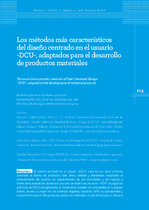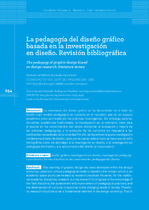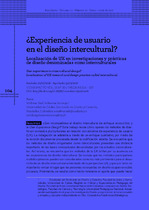| dc.contributor.author | Trujillo Suárez, Manuel | |
| dc.contributor.author | Aguilar, José Javier | |
| dc.contributor.author | Neira, Claudia | |
| dc.coverage.spatial | Seccional Medellín | spa |
| dc.date.accessioned | 2021-01-22T15:09:07Z | |
| dc.date.available | 2021-01-22T15:09:07Z | |
| dc.date.issued | 2016 | |
| dc.identifier.uri | http://hdl.handle.net/20.500.11912/7541 | |
| dc.description | p. 215 - 236 | spa |
| dc.description.abstract | El diseño centrado en el usuario –DCU- nace en los años ochenta, orientado al diseño de productos más útiles, usables y deseables; mejorando el entendimiento del usuario, los requerimientos de sus actividades, y las mejoras a través de la evaluación, durante el proceso de diseño de producto –PDP-. Aunque las prácticas del DCU son generales e inicialmente pueden ser empleadas en cualquier diseño, tienen su origen en los sistemas digitales, haciendo difícil su aplicabilidad y comprensión para el desarrollo de productos materiales, lo que disminuye su eficacia y facilidad para su uso. Esta investigación plantea una revisión bibliográfica de los métodos más característicos para el diseño de productos materiales durante el PDP, pero teniendo como base aquellos de los sistemas digitales. Cabe señalar que hay evidencias de la pertinencia de los métodos del DCU para la generación de ideas y la definición y evaluación del producto, sin embargo, las prácticas propuestas aquí son todavía un compendio extenso, siendo necesario en futuros estudios definir criterios de selección, según las necesidades del equipo de desarrollo. Se concluye: primero, que los métodos del DCU para los sistemas digitales y para los productos materiales deben tener orientaciones diferentes; segundo, a pesar de que estos métodos ayudan a reducir los tiempos de desarrollo y la incertidumbre de adopción, no son por sí solos garantía del éxito en el mercado; tercero, los diseñadores deben conocer el sector y la organización para desarrollar artefactos contextualizados; por último, por ser materiales, debe haber otros métodos para impulsar una economía responsable de bajo impacto ambiental y con equidad social. | spa |
| dc.description.abstract | User-Centered Design or UCD was born in the 1980s, aimed at designing more useful, usable and desirable products. It has helped to optimize the understanding of the user and the requirements of his activities, and to carry out improvement actions through assessment during the product design process or PDP. Although UCD practices are general and can initially be used in any design, they have their origin in digital systems, making its applicability and its understanding for the development of materials difficult, which reduces its effectiveness and ease of use. This research starts with a literature review of the most characteristic methods for the design of material products during the PDP, and it takes those referred to digital systems as a base. It should be noted that there is evidence of the relevance of UCD methods for the generation of ideas and the definition and assessment of the product. However, the practices proposed here are still an extensive compendium, which turn it necessary to carry out future studies to define selection criteria, according to the needs of the development team. Conclusions: first, UCD methods for digital systems and for material products must have different guidelines; second, while these methods help reduce development times and the uncertainty of adoption, they are not alone a guarantee of success in the market; third, designers need to know the organization and the sector in order to develop contextualized artifacts; finally, because they are materials, there must be other methods to boost an economy that is responsible for low environmental impact and with social equity. | spa |
| dc.format.mimetype | application/pdf | |
| dc.language.iso | spa | |
| dc.publisher | Universidad Pontificia Bolivariana | spa |
| dc.relation.ispartof | Iconofacto | spa |
| dc.rights | Attribution-NonCommercial-NoDerivatives 4.0 International | * |
| dc.rights.uri | http://creativecommons.org/licenses/by-nc-nd/4.0/ | * |
| dc.subject | Diseño Centrado en el Usuario DCU | spa |
| dc.subject | Desarrollo de producto | spa |
| dc.subject | Métodos del diseño | spa |
| dc.subject | Diseño industrial | spa |
| dc.subject | Pensamiento en diseño | spa |
| dc.subject | Proceso de Diseño de Producto | spa |
| dc.subject | User-Centered Design –UCD– | spa |
| dc.subject | Product development | spa |
| dc.subject | Design methods | spa |
| dc.subject | Industrial design | spa |
| dc.subject | Design thinking | spa |
| dc.subject | Product Design Process –PDP– | spa |
| dc.title | Los métodos más característicos del diseño centrado en el usuario -DCU-, adaptados para el desarrollo de productos materiales | spa |
| dc.title.alternative | The most characteristic methods of User-Centered Design –UCD– adapted to the development of material products | spa |
| dc.type | article | spa |
| dc.rights.accessRights | openAccess | spa |
| dc.type.hasVersion | publishedVersion | spa |
| dc.description.sectional | Medellín | spa |
| dc.identifier.instname | instname:Universidad Pontificia Bolivariana | spa |
| dc.identifier.reponame | reponame:Repositorio Institucional de la Universidad Pontificia Bolivariana | spa |
| dc.identifier.repourl | repourl:https://repository.unab.edu.co/ | |





